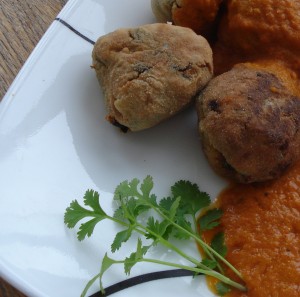A few weeks ago I took my first foray into Kofta (i.e. Meatball) Curry. The meatballs I made turned out quite pleasing, but the curry sauce recipe I made to accompany them was disappointing. Somehow a recipe that looked to contain all manner of interesting flavors ended up underwhelming and bland.
I resolved to have another go at Kofta Curry, in particular the curry sauce. I contemplated what might have gone wrong in the sauce recipe I used last time, and how it might be fixed. I considered what makes other, similar tomato-based curries (such Tikka Masala or Makhani) that I know and love so tasty. I resolved to pool several curry recipes, including my Tikka Masala and Makhani recipes and a number of Kofta Curry recipes I found online, comparing and contrasting them, taking the common ingredients, adopting uncommon ingredients with special promise, and getting rid of ingredients or methods that appeared troublesome… all with the hope that the resulting recipe would embody all of the glorious flavor one could ever hope for in a Kofta Curry!
Well, at least I wanted it to be tastier than the recipe I tried two weeks ago. And in that goal, at least, I succeeded. While I don’t claim it is the pinnacle of all curry on Earth, it turns out to be a pretty darned good tomato curry with its own character, similar in some ways, but also distinct from the other types of curry recipes I consulted.
SARAH’S DEFINITIVE KOFTA CURRY SAUCE
 1 oz butter
1 oz butter
1 onion, peeled and chopped
2 cloves garlic (1 teaspoon minced)
1 tablespoon ground ginger
1-2 tablespoons lemon juice
1 teaspoon ground red pepper or paprika
1/2 teaspoon turmeric
1 teaspoon garam masala
1 teaspoon ground coriander
1/2 teaspoon cumin
1/2 teaspoon cinnamon
1/2 teaspoon poppy seeds
1 can diced tomatoes
1 (6oz) can tomato paste
water, as needed
1/2 to 1 cup cream or beaten yogurt
cashews
cilantro
Saute the onion and garlic in the butter. Add spices and other ingredients as they simmer. After adding the tomatoes, a little water may be needed if the sauce is too thick. Depending on how long you simmer the sauce (i.e. if you’re going to use it to stew meat, or just keep it warm on the stove while cooking other things), you may need to add a little water as it cooks to keep it at that desired gravy-like consistency.
I’m a fan of smooth sauces, so I used my immersion blender to process this sauce; however if you prefer a chunkier sauce there is really no need to process it, as there are no whole spices in this recipe. Add the cream shortly before serving, and heat through. Serve with kofta meatballs or vegetable balls. Garnish with cashews and fresh cilantro.
The only adjustment I made to this recipe after trying it was that I added an option for less lemon juice. I used the full 2 tablespoons when I made this recipe; when I ate the sauce a second time as leftovers, I noticed it was just a tad acidic after sitting a day in the fridge. Probably adding additional cream would help to tame this acidity, but I may use only one tablespoon of lemon juice in the future.
One day soon, I hope to try this sauce with my previous Kofta Meatball recipe, but in the interest of keeping my repertoire varied, but this past weekend I decided to try a recipe for Spinach Kofta.
I spoke in my afore-referenced blog about different varieties of kofta. Among the Malai (i.e. vegetable) koftas, there seems to be quite a lot of variation from one recipe to another in terms of what vegetables are used. Sometimes the variance is minor, sometimes two recipes will use different vegetables altogether.
I decided to start with a recipe for spinach kofta, as it looked easy enough to make with things I already had around the house. As the recipe called for mashed potatoes, rather than chopped potatoes, I knew I could use my favorite potato substitute, canned yams.
 SARAH’S SPINACH & YAM KOFTAS
SARAH’S SPINACH & YAM KOFTAS
1 (29oz) or 2 (16oz) can(s) of yams, thoroughly rinsed and drained
1/2 lb. frozen spinach (i.e. half a 1 lb. bag), thawed
2 green chilis, diced
2 tablespoons cottage cheese (optional)
1 teaspoon salt
1/2 to 1 teaspoon paprika or cayenne
1 tablespoon ground ginger
1 egg
1/4 cup plain breadcrumbs
corn flour or besan (chickpea) flour
oil
Mash the yams in a bowl with the spinach. Mix in the remaining ingredients up to and including the breadcrumbs. Form golf-sized balls (add more breadcrumbs if the mixture is too moist). Roll the balls in corn flour.
Heat oil in a small skillet or deep fryer. Fry the kofta balls, drain on a towel, serve with my Definitive Kofta Curry Sauce.
A few notes on this recipe. I indicate that the cottage cheese is optional, not because I think that one would want to omit it for any particular reason, but rather because I accidentally left it out when making my kofta balls this weekend (in fact, now I’m stuck with an enormous tub of cottage cheese and nothing to do with it). They were tasty enough without it, but cheese can only make them better, right?
Finally, a note on frying. When a cooking method akin to deep frying is called for, as in this recipe, I use a modified shallow fry. Deep frying can be such a waste of oil that I try to avoid it. For these koftas, I used my smallest skillet filled with about 1/2 to 3/4 inch of oil (i.e. about half the diameter of the kofta balls). I let the koftas fry a half at a time, rolling them around until they got done on all sides.








